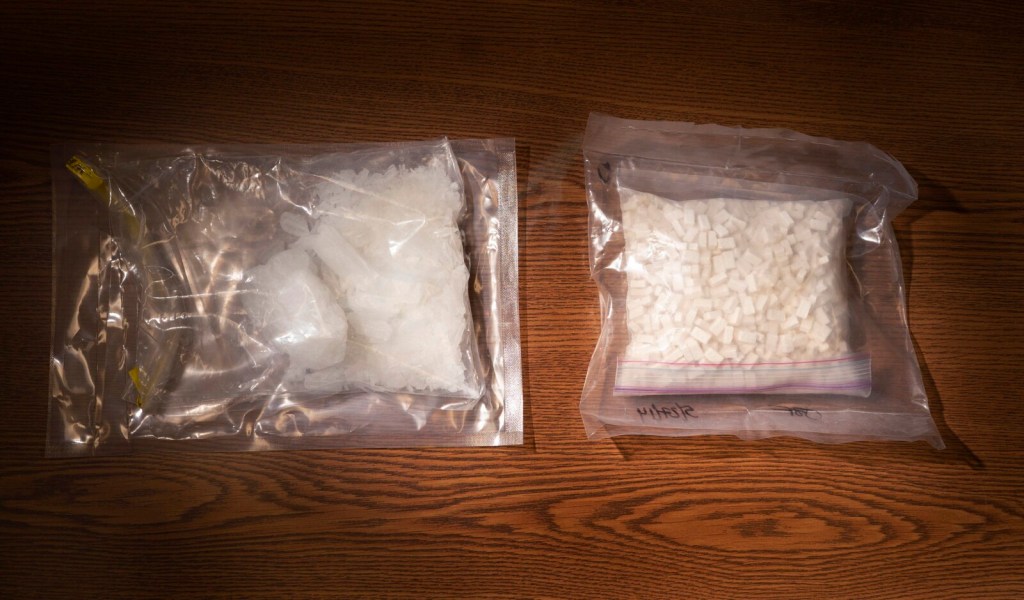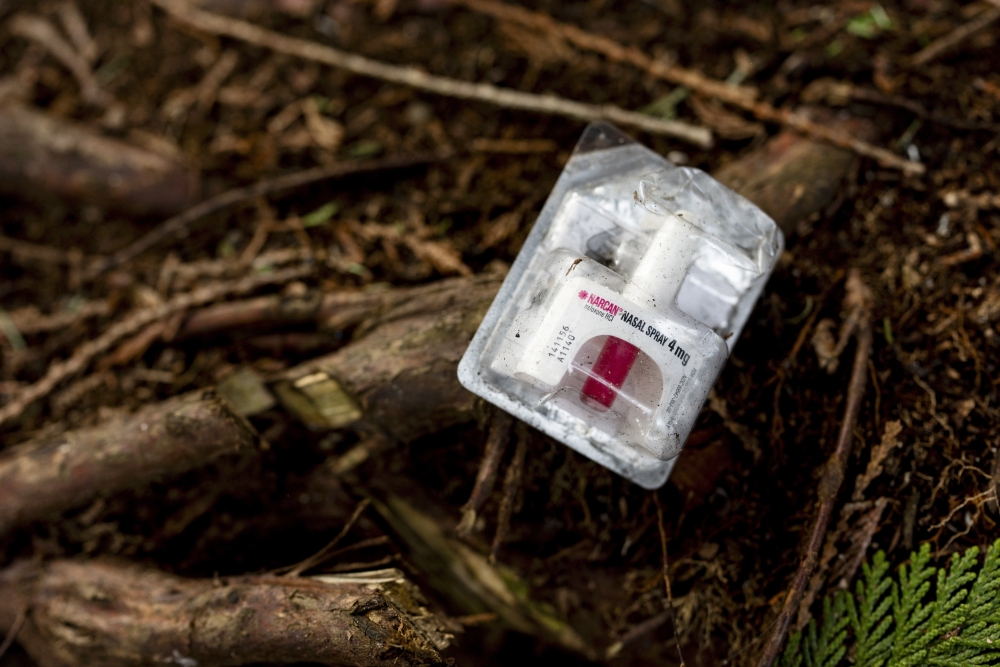After years of coordinated effort, Maine has begun to turn the tide in the war on opioids.
Fatal overdoses were down 20% last year, thanks largely to the distribution of more than half a million doses of naloxone, the overdose reversal drug, since 2019. Suboxone, the primary drug used to treat opioid addiction, is the most prescribed medication in the state, according to a recent report from the Department of Health and Human Services. And an extensive network of advocates, nonprofits, law enforcement agencies and medical providers works every day to steer Mainers with substance use disorder toward harm reduction practices and recovery resources.
But now, a system designed to fight one crisis is straining to contain another: the growing number of people in Maine who supplement opioid use with methamphetamines and other stimulants — a combination experts say poses challenges for the state’s recovery infrastructure.
“(Meth) really is on the rise — much more so than I’ve seen ever here in Maine,” said Jen Giggey, Sweetser’s Cumberland County liaison to the state’s OPTIONS initiative (Overdose Prevention Through Intensive Outreach, Naloxone, and Safety). “We are seeing it everywhere. I don’t think there’s a county that’s saying they’re unscathed.”

A recent New York Times report painted a harrowing picture of a “meth onslaught” that has devastated Portland’s Bayside neighborhood and stymied local police and recovery resources. According to their reporting, the stimulant has arrived in large quantities from the nation’s southern border as rising fentanyl costs have pushed Mainers toward other options.
Experts say that’s largely true in Portland and beyond. But there’s more to the story.
Meth use is not new to Maine. In some parts of the state, like Aroostook County, it has long existed as a culture unto itself — a problem some advocates say hasn’t gotten enough attention compared to the opioid crisis. And while it’s true that meth appears to be on the rise throughout the state, it hasn’t so much replaced opioids like fentanyl as it has joined them in what looks like a new stage of Maine’s drug crisis.
Fentanyl remains the main cause of overdose deaths, but greater percentages of those victims also have meth in their systems at the time of death. Between 2018 and 2024, that number rose from 7% to 37%, according to data shared by Gordon Smith, Maine’s director of opioid response.
Addiction and recovery experts offered several theories for why and how meth use has taken hold in Maine, some of which include a tightening of the fentanyl supply or increased availability of the stimulant.
For some people who struggle with addiction, this “polysubstance” trend could make recovery more challenging, though experts warn against painting with too broad a brush. Others fear that the increasing visibility of meth use — which can sometimes cause erratic behavior that is disturbing to witness — could stigmatize an already marginalized group and contribute to a public backlash against the harm reduction policies that experts support.
A CULTURE OF METH
Justin Martin wasn’t homeless. He wasn’t raving on the street or screaming about bugs on his skin, and he never missed a day of work at his construction job.
His was the face of a different kind of meth addiction.
“I wasn’t a mess or anything like that,” said Martin, who now helps guide others toward recovery as an Aroostook County OPTIONS liaison. “It simply allowed me to get up and work an 18-hour long workday and do it the next day and the next day and the next day.”
People without close connections to the substance abuse world sometimes make the mistake of thinking that drugs are interchangeable and that the people who use them will take anything they can find to get high. But most people who turn to drugs do so for a specific reason, Martin said. For blue collar workers who need to juggle multiple jobs just to make ends meet, stimulants are a functional choice.
Truckers use it to stay up through the night. Homeless people use it to stay alert on the streets when going to sleep could put them in physical danger.

“If you don’t have a place to stay, you need to walk around for the next 10 hours, meth will help you do that,” Martin said. “And it will work; it’s effective.”
Meth might be the new game in places like Portland. But in Aroostook County, where it’s had a foothold for years, opioids are seeping into meth culture just as much as the reverse, according to Sarah Corbett, a drug and alcohol counselor at Aroostook Mental Health Center in Caribou.
Some people who use meth are coming in for screening tests and discovering that fentanyl is in their system because their supply had been tainted with the highly potent opioid, she said.
That has contributed to a rise in the percentage of fatal overdoses involving meth, even though the overall number of ODs has come down in recent years. In 2024, meth was present in 168 of 452 fatal overdose victims, according to data provided by Smith. Most of those deaths also involved fentanyl.
“Our problem, in terms of trying to keep people alive, is still mostly fentanyl,” Smith said.
POLAR OPPOSITES
Though it’s difficult to overstate just how destructive opioids have been for a generation of Mainers, addiction experts say they now have solid, evidence-based strategies for combating the crisis.
A dose of naloxone, commonly administered as a fast-acting nasal spray, can immediately reverse the nervous system-depressing effects of fentanyl, said Bill Burns, the Portland Police Department’s substance abuse disorder liaison.
Opioid users looking to enter recovery have access to a broad range of resources, including medication-assisted treatment, which involves using drugs like suboxone to dull cravings and withdrawal symptoms.
“We’ve become quite good at treating opioids,” Smith said.

Meth is a different story.
The stimulant, when untainted by fentanyl or other contaminants, is unlikely to cause a sudden fatal overdose. But it can produce effects that are difficult to manage.
“It’s the polar opposite of what we’re used to dealing with,” said Giggey, the Cumberland County OPTIONS liaison. “With the opioids, we’re used to people being sluggish and slow and tired. These guys are wired, bouncing off the walls.”
It can be difficult to distinguish a person coming down from a meth binge from a person in the throes of a mental health crisis, Giggey said. Sometimes called “tweaking,” a term experts say is stigmatizing, this stage of meth use can come with paranoid delusions, herky-jerky movements and erratic behavior that can frighten onlookers.
Even when police or medical providers do determine that drugs, not mental illness, are at the root of an episode, there’s sometimes not much to do other than to get them to a safe place and wait for them to come down — not always an easy task, according to Burns.
Meth, which can over time lead to stroke or heart attack, does not respond to naloxone. Medication-assisted treatment is also ineffective, which can make meth use an especially difficult addiction to break, according to some in the Maine recovery sphere.
DIFFERENT PATHS
“If you’ve met one addict, you’ve met one addict,” said Martin, the Aroostook County OPTIONS liaison. The joke underscores a point that recovery experts regularly stress — the tens of millions of Americans who battle substance use disorder are not a monolith, and it can be dangerous to treat them as such.
There’s broad agreement that more people in Maine are using both opioids like fentanyl and methamphetamine, but they get there in different ways.
Some might become addicted to opioids after inadvertently smoking fentanyl-laced meth. Others use meth and other stimulants to balance out the depressive effects of fentanyl.
That cycle can be difficult to break, said Ryan Paige, with the nonprofit Access Direct Recovery Network, which helps connect people with substance abuse disorder to recovery resources throughout Maine and beyond.
He knows from experience.
Before he entered recovery in 2019, Paige had success weaning himself off opioids with the help of medication-assisted treatment. But he hadn’t done the work of treating the substance abuse disorder that was the root of his addiction, he said. That left him vulnerable.
“There was a time when I felt like if I wasn’t doing heroin or fentanyl, and I wasn’t dependent on the substance, then I didn’t really have a problem — I could do cocaine or crack or meth,” he said. Like many of the people Paige now helps, he soon turned back to opioids and other depressants to bring him back to baseline after using stimulants.
Major Mark Dyer, of the Sanford Police Department, and Giggey also said the presence of a meth addiction can make it harder to quit fentanyl.
“The meth seems to have a much higher relapse rate,” Giggey said. “It seems like it grabs onto people psychologically in a way that they are unable to shake.”
But Burns in Portland and Corbett in Caribou say that’s not always true. Burns has seen people make progress in their opioid recovery even if they don’t get treatment for their stimulant use, and, for some, breaking the depressive part of the drug cycle makes it easier to stop using meth because they no longer need the extra energy it provides.
Some might be turning to meth because it can be cooked relatively easily close to home — perhaps by someone the user trusts to produce a fentanyl-free product. Others say this new wave of meth is mostly coming from outside the state. The number of police raids of meth cooking sites is down dramatically from several years ago, according to Smith, who said the internet has made it easy for people to get drugs delivered through the mail.
ADDRESSING DEMAND, NOT SUPPLY
Anecdotally, police departments say they’re responding to more calls involving people using meth. But there’s little good data available to quantify the trend because departments generally don’t track it.
Smith said it’s important to study changes in the drug supply and usage patterns so the state can tweak its recovery strategies to meet people where they are — such as by allowing people to continue pursuing medication-assisted treatment for opioid addiction even if they test positive for other types of drugs.
But the war on drugs is not likely to be won by shutting down the supply, he said.
“We have chased these drugs around for at least since the Nixon era 50 years ago. And to what end,” Smith said. “There are arguably more drugs available in the country right now than there have ever been before.”
Instead, recovery advocates say the government must do more to address the issues that lead to a demand for drugs: child poverty, homelessness, issues with the foster system, education disparities.
By ignoring those systemic issues and instead fixating on the ugliest end results of the crisis, like homeless people acting erratically on the street in Bayside, they worry that Maine could stigmatize people with substance abuse further and push the public away from the harm reduction policies that could help keep them alive.
“People were in fear of people with substance abuse disorder before meth, and now, with the psychosis and with the ways that folks act out on meth, it will promote more fear,” Paige said. “It’s more public, so that will be a thing.”

We invite you to add your comments. We encourage a thoughtful exchange of ideas and information on this website. By joining the conversation, you are agreeing to our commenting policy and terms of use. More information is found on our FAQs. You can modify your screen name here.
Comments are managed by our staff during regular business hours Monday through Friday as well as limited hours on Saturday and Sunday. Comments held for moderation outside of those hours may take longer to approve.
Join the Conversation
Please sign into your CentralMaine.com account to participate in conversations below. If you do not have an account, you can register or subscribe. Questions? Please see our FAQs.